Casey Stoner qualified on pole for the MotoGP race at Circuit de Catalunya, looking as though he might just cruise away from the field as he has so often done. Yet in the race, he finished in lowly (for him) fourth place, saying that his tire never really heated up. Stoner and his Repsol Honda teammate, Dani Pedrosa, were the only top riders who chose the harder of two available Bridgestone rear tires. Winner Jorge Lorenzo, who battled with Pedrosa until a few laps from the finish, had chosen the softer tire.
How do riders decide which tire to use, and why do the top men in the game sometimes come to opposite choices?
First comes the difference in machines. Over many years, the Yamahas (Lorenzo, Cal Crutchlow, Ben Spies, Andrea Dovizioso) have tended to have smoother powerbands and more stable chassis, both of which conserve rather than abuse tires. Honda has always sought all the horsepower its large R&D resources can produce and then look for ways (and riders) to make it usable. Although the Hondas have looked less-choppy and easier-to-ride since mid-2010, their lap times are still horsepower-based. Add to this the fact that Stoner, like Kenny Roberts so many years ago, is skilled in making his motorcycle steer on the throttle when it won’t steer on the front wheel. Power plus throttle-steering ask a lot from a rear tire.
The weather in Spain played games. Saturday was really hot. “I think everyone is struggling a little on the soft-compound tire,” said Stoner. “This afternoon, we used the harder tire, and they seemed a little more consistent. With these hot conditions, the oil and everything start coming up through the track and makes things a little tricky.”
For qualifying, Stoner and the others used the soft tire. "Honda will probably use the hard compound ," said Stoner, "with which the chatter issues are exaggerated, especially if Sunday is also swelteringly hot." On Saturday, air temperature was "only" 84 degrees Fahrenheit, but the pavement was an egg-frying 125. Qualifying order was: Stoner, Lorenzo, Crutchlow, Spies and Pedrosa.
Stoner has had chatter all year, and the usual measures have failed thus far to quell it. Up to a point, a rider can change his style, push less hard and ride just on the doorstep of chatter. But push any harder and the chatter increases, forcing the bike rapidly off-line. Stoner noted that all he had to do was "touch the throttle" and the rear would begin to chatter. Add to that the fact that chatter seemed to be worse with the hard tire.
Spies, on a factory Yamaha, made his fastest lap on Saturday on a soft rear that had already done 29 laps (the race is 25). This knowledge had enormous value, for it answered a basic question everyone had to answer: Will the new, faster-to-warm-up 2012 Bridgestones give up prematurely, as has happened in earlier events? If so, the harder tire would be the choice. But if not…
Lorenzo is known for doing race-distance simulations to be sure of tire choices. Stoner prefers to use that time to work on setup. The Yamaha men, armed with the aforementioned knowledge, riding kinder-to-tires YZR-M1s and without serious chatter, were ready to put on softs if Sunday were not oven-hot.
Pedrosa was quoted as saying, “Our main target today has been to properly test the tires because it will be very important to make the right choice for the race. Here, in the past, the soft tire worked quite well with high temperatures, but we still don’t know how long it will last.”
For reasons still unclear, Pedrosa’s hard rear worked well enough that he was able to fight with Lorenzo until close to the end, repassing him on engine power down the long straight and being himself passed on the brakes in a cycle that finally favored Lorenzo.
Stoner’s hard rear never delivered the grip he needed to race with. Sunday’s track temperature was 25 degrees cooler than Saturday’s, partly owing to the cooling effect of a morning rain. According to Bridgestone, this added up to “lower grip levels than experienced on Friday and Saturday.”
“Looking at it,” said Stoner after the race, “the way the race went, the softer choice could have been better. But with our bike, we were running a little too high in temperatures with the soft tire, and that’s why we were concerned we could have some issues at the end of the race.
“Trying to get grip and trying to make the bike work was a little bit more physical, so my legs are destroyed; my arms not so much. I was trying to stand on the pegs to get some traction, trying to stop the bike wheelying when the traction did arrive, all kinds of things. It was a little bit tiring at the end, but I only felt it after the race. Maybe was the wrong choice, but it was the safer choice for us.
Crutchlow, on a satellite Tech 3 Yamaha, strove to pass Stoner but could not. “Each time I’d close up, he would pull away and manage the gap,” said Crutchlow. “I couldn’t do anything else to get by him, but he’s not the world champion for nothing.”
“It could have gone completely wrong,” summed up Stoner. “We could have blistered the tire and gone backward at the end, so it was better we were at least fighting for the back of a podium than dropping back. At the end, I just started pushing more than I am usually comfortable with, pushing deeper on the braking points, taking some risks, just trying to close that gap.” The finish order: Lorenzo, Pedrosa, Dovizioso, Stoner, Crutchlow.
Lorenzo was third for a time, pushing hard enough to keep the men ahead under pressure which, experience told him, would produce “useful mistakes.” The faster you go, the less perfect everything becomes.
“Later in the race, I waited for my opportunity,” said Lorenzo, “and could see Dani was slowing down. So, when he made a mistake, I profited from it and then pushed to the maximum to take the win.”











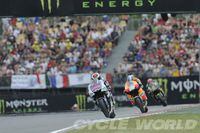
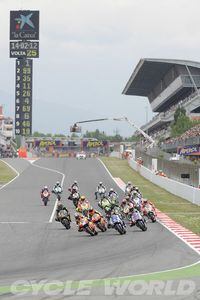
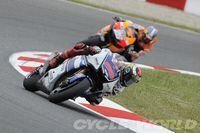
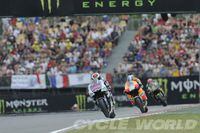
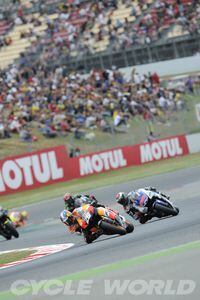
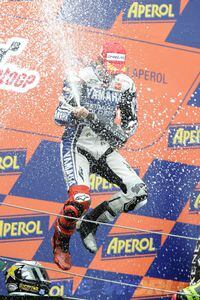
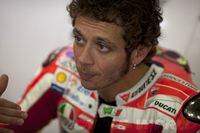
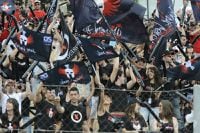
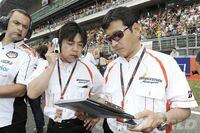
/cloudfront-us-east-1.images.arcpublishing.com/octane/RO36KTIVYZEATJW7CCB77EQHLQ.jpg)
/cloudfront-us-east-1.images.arcpublishing.com/octane/BUIUXSLF5RFRVJ3E26VRO5V2AY.jpg)
/cloudfront-us-east-1.images.arcpublishing.com/octane/EJJ2JBBSEZAWLFCRDALQOIBFVU.jpg)
/cloudfront-us-east-1.images.arcpublishing.com/octane/WVYKJFMINVFMFH37AE4OUEWVIM.jpg)
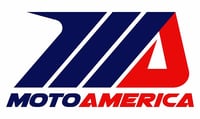
/cloudfront-us-east-1.images.arcpublishing.com/octane/JJ3MC6GNDFF5ZNYD3KD3E4EY7Y.jpg)
/cloudfront-us-east-1.images.arcpublishing.com/octane/XH2ETEU4NVGDFNQO2XT2QQS5LU.jpg)
/cloudfront-us-east-1.images.arcpublishing.com/octane/UFG652C27BDBFPK42TDAJ5CMX4.jpg)
/cloudfront-us-east-1.images.arcpublishing.com/octane/AUE3NFVRRZDSBIDVUGIYIDQNUI.jpg)
/cloudfront-us-east-1.images.arcpublishing.com/octane/LYR62CH2WNBMHJJVXVATZHOUE4.jpg)
/cloudfront-us-east-1.images.arcpublishing.com/octane/RBCTRGBQYBDK7A6XPG3HKPS7ZQ.jpg)
/cloudfront-us-east-1.images.arcpublishing.com/octane/MQXQRYMZVBCWJIRYP3HEN3SHVE.jpg)
/cloudfront-us-east-1.images.arcpublishing.com/octane/TSPODNNEWRDSVJGUCNQTDG4ADI.jpg)
/cloudfront-us-east-1.images.arcpublishing.com/octane/X5TB7BDV4BA2RPSY54ZGK27RP4.jpg)
/cloudfront-us-east-1.images.arcpublishing.com/octane/REUHOJXRDBGZ5IHBYZCCBCISPA.jpg)
/cloudfront-us-east-1.images.arcpublishing.com/octane/52LGJTCKBFEHDF7S7H4CVUIMGM.jpg)
/cloudfront-us-east-1.images.arcpublishing.com/octane/YMWAIPIPSJAOXOU3QMJMGH37OM.jpg)


/cloudfront-us-east-1.images.arcpublishing.com/octane/EJ6KZRGAYBCVXNL2PJXL37UVWQ.jpg)
/cloudfront-us-east-1.images.arcpublishing.com/octane/AAN4TI76M5H5JMUVEIGASWXBDU.jpg)
/cloudfront-us-east-1.images.arcpublishing.com/octane/P3RXD2UCPFF37CMB7CHPVKXORY.jpg)
/cloudfront-us-east-1.images.arcpublishing.com/octane/VZEG2EJI2RDFZNHLRZMU56MD3Q.jpg)
/cloudfront-us-east-1.images.arcpublishing.com/octane/GVJQO5FFOFBWNGODOBRB4FBAW4.jpg)